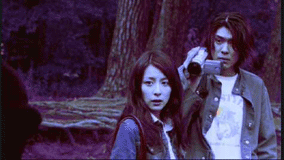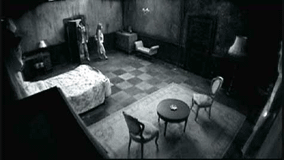St. Johnís Wort (Shimoyama Ten) 2002
 Thereís a movie based on Resident Evil coming out next week, and
although I havenít seen it yet, I imagine that it doesnít pay homage to its
source material nearly as creatively as St. Johnís Wort, a Japanese
horror film similarly based on a videogame, does. Harnessing its roots as an
opportunity to use digital effects in a manner usually reserved for television
commercials and movie trailers, St. Johnís Wort feels like it doesnít
realize the boundaries that other films insist exist between media. Usually the
dawning of new media is portrayed in films as an oppressive force. I found
Kiyoshi Kurosawaís Pulse a total drag because of its insistence that we
were all rendered zombies thanks to our advanced gadgetry, and because it had a
style to match. St. Johnís Wortís vision of todayís technology is
quite the opposite, and its style is ceaselessly inventive. Instead of the
botanist teenagers of Pulse, Wortís characters are computer game
programmers. Their know-how and cyber-connectedness are save them several times
after they enter the haunted mansion that the film takes place in. It empowers
them to recreate their world in a digital version that can be manipulated
however they want, and the wealth of information available to them at any
moment, enabling them to solve the mysteries of the house, is mind-boggling.
Thereís a movie based on Resident Evil coming out next week, and
although I havenít seen it yet, I imagine that it doesnít pay homage to its
source material nearly as creatively as St. Johnís Wort, a Japanese
horror film similarly based on a videogame, does. Harnessing its roots as an
opportunity to use digital effects in a manner usually reserved for television
commercials and movie trailers, St. Johnís Wort feels like it doesnít
realize the boundaries that other films insist exist between media. Usually the
dawning of new media is portrayed in films as an oppressive force. I found
Kiyoshi Kurosawaís Pulse a total drag because of its insistence that we
were all rendered zombies thanks to our advanced gadgetry, and because it had a
style to match. St. Johnís Wortís vision of todayís technology is
quite the opposite, and its style is ceaselessly inventive. Instead of the
botanist teenagers of Pulse, Wortís characters are computer game
programmers. Their know-how and cyber-connectedness are save them several times
after they enter the haunted mansion that the film takes place in. It empowers
them to recreate their world in a digital version that can be manipulated
however they want, and the wealth of information available to them at any
moment, enabling them to solve the mysteries of the house, is mind-boggling.
 Beyond the most obvious ways that the filmís
techno-obsessions filter into the movie, it seems as if the entire filmmaking
process has benefited from technological advances. The script seems to revel in
the simplicity of its own plot, which has presumably been borrowed from the
source videogame. Several expositional scenes are played out not with actors,
but instead with text boxes and silhouette portraits of the characters, as we
would see in an adventure game. Some of the sets are quite obviously computer
generated, too colorful to be taken seriously, adding to the feeling that
reality itself might not be as we perceive it. The exploration of the mansion,
in homage to The Blair Witch Project, mainly takes place in the first
person perspective, adding to the feel that weíre participants in the story.
These scenes are interrupted by images taken from fixed surveillance cameras
scattered throughout the estate, and when one of those images is rewound and
zoomed, the movie is sophisticatedly telling us that they arenít alone in the
house. Itís the use of perspective, not necessarily the shocking source
material, is what provided the greatest jolts for me. When a characterís eyes
are getting gouged out, the audience sees the knife coming at it in a first
person perspective, and it feels as if weíre under assault ourselves.
Beyond the most obvious ways that the filmís
techno-obsessions filter into the movie, it seems as if the entire filmmaking
process has benefited from technological advances. The script seems to revel in
the simplicity of its own plot, which has presumably been borrowed from the
source videogame. Several expositional scenes are played out not with actors,
but instead with text boxes and silhouette portraits of the characters, as we
would see in an adventure game. Some of the sets are quite obviously computer
generated, too colorful to be taken seriously, adding to the feeling that
reality itself might not be as we perceive it. The exploration of the mansion,
in homage to The Blair Witch Project, mainly takes place in the first
person perspective, adding to the feel that weíre participants in the story.
These scenes are interrupted by images taken from fixed surveillance cameras
scattered throughout the estate, and when one of those images is rewound and
zoomed, the movie is sophisticatedly telling us that they arenít alone in the
house. Itís the use of perspective, not necessarily the shocking source
material, is what provided the greatest jolts for me. When a characterís eyes
are getting gouged out, the audience sees the knife coming at it in a first
person perspective, and it feels as if weíre under assault ourselves.
 The editing in St. Johnís Wort seems to have been freed from normal
conventions, and the film is sped up, looped, and otherwise minced with
regularity. The boring parts of the action are judiciously excised, resulting in
a tight, unsettling work. The plot may be simple here, and the acting over the
top, but that will strike someone thatís played a few video games as utterly
beside the point, especially since the scares deliver, and the mood is
consistent. Hollywood is consistently taking flak for its inability (or perhaps
willingness) to convert popular videogames to the big screen. St. Johnís
Wort seems to suggest an answer in which the workís roots are not denied,
but somehow the cinematic energy of the film is not diminished at all. Unlike
those who made Tomb Raider or Mortal Kombat, Shimoyama Ten
realizes that videogames are allowed to coast by with their diminished plots
because they provide a barrage of exciting images, and the feeling that weíre
involved with, or impacting the storyís outcome. Letís hope that future film
conversions from games follow St. Johnís Wortís lead.
The editing in St. Johnís Wort seems to have been freed from normal
conventions, and the film is sped up, looped, and otherwise minced with
regularity. The boring parts of the action are judiciously excised, resulting in
a tight, unsettling work. The plot may be simple here, and the acting over the
top, but that will strike someone thatís played a few video games as utterly
beside the point, especially since the scares deliver, and the mood is
consistent. Hollywood is consistently taking flak for its inability (or perhaps
willingness) to convert popular videogames to the big screen. St. Johnís
Wort seems to suggest an answer in which the workís roots are not denied,
but somehow the cinematic energy of the film is not diminished at all. Unlike
those who made Tomb Raider or Mortal Kombat, Shimoyama Ten
realizes that videogames are allowed to coast by with their diminished plots
because they provide a barrage of exciting images, and the feeling that weíre
involved with, or impacting the storyís outcome. Letís hope that future film
conversions from games follow St. Johnís Wortís lead.
***1/2
03-09-02
Jeremy Heilman